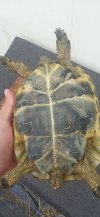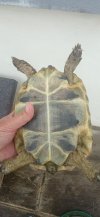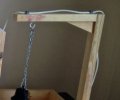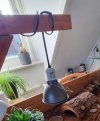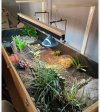Update5063
New Member
Hello, long timer lurker, first time poster. Thanks for all the great info here.
I have 2 eastern hermanns. I incubated and have cared for since they hatched 6 years ago. Since birth 1 has been noticeably larger / more rounded than the other - and is something around 40-50% heavier / bigger - despite eating the same, the smaller one is not being bullied or pushed off food.
In the last year or so the bigger of the 2 is noticeably taller, the other more flat. I believed till now they are both female - short tails, flat plastron, same length nails, same narrow V on the anal scute (I think its called) - even though 1 is much bigger.
They are really friendly, live together, no issues, but the past few weeks the smaller one has been chasing the larger one around the garden, not very often only 2-3 times, and yesterday tried to mount the larger one. Its not constant hassle - so im not worried - but just wanted to check what the experts thought.
Is this behaviour normal - or do I secretly have a male......
I have 2 eastern hermanns. I incubated and have cared for since they hatched 6 years ago. Since birth 1 has been noticeably larger / more rounded than the other - and is something around 40-50% heavier / bigger - despite eating the same, the smaller one is not being bullied or pushed off food.
In the last year or so the bigger of the 2 is noticeably taller, the other more flat. I believed till now they are both female - short tails, flat plastron, same length nails, same narrow V on the anal scute (I think its called) - even though 1 is much bigger.
They are really friendly, live together, no issues, but the past few weeks the smaller one has been chasing the larger one around the garden, not very often only 2-3 times, and yesterday tried to mount the larger one. Its not constant hassle - so im not worried - but just wanted to check what the experts thought.
Is this behaviour normal - or do I secretly have a male......

